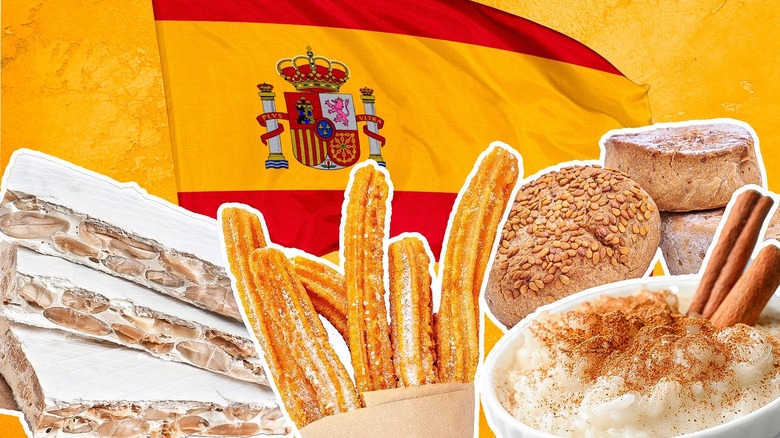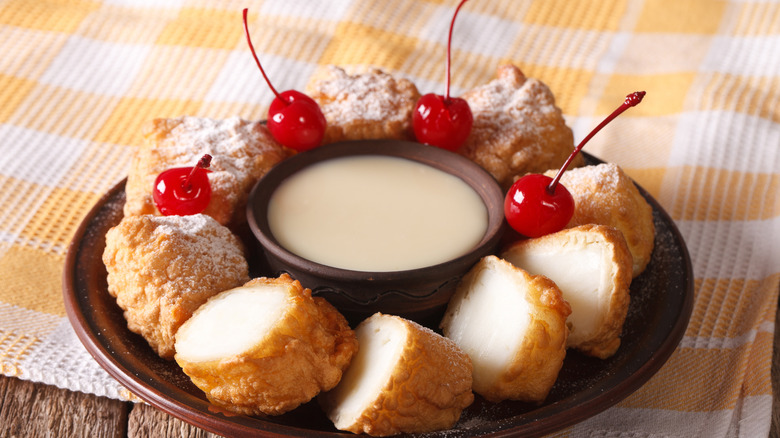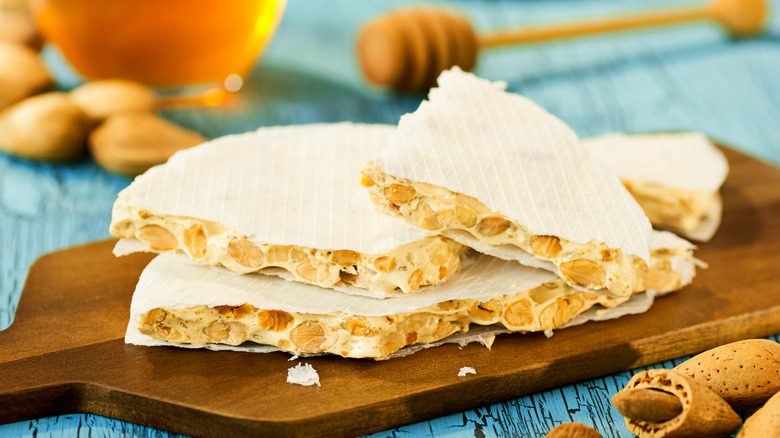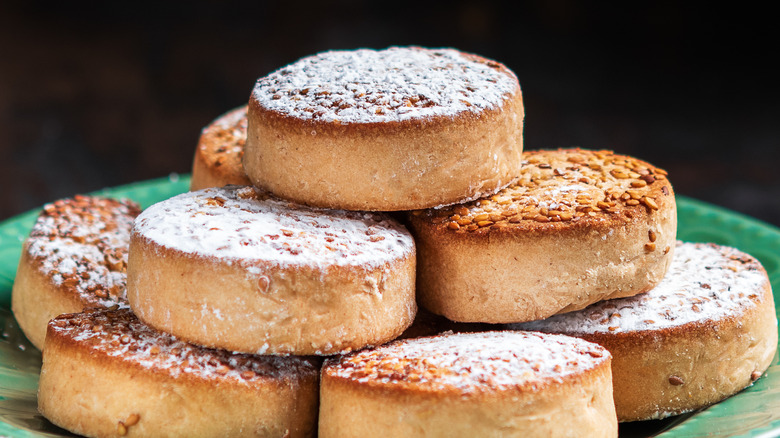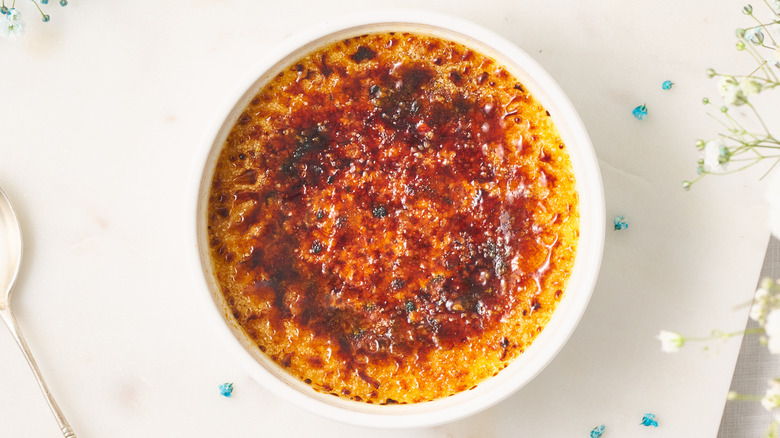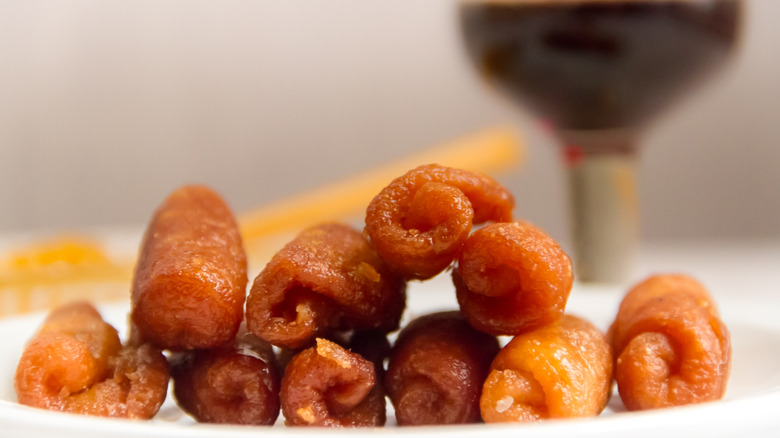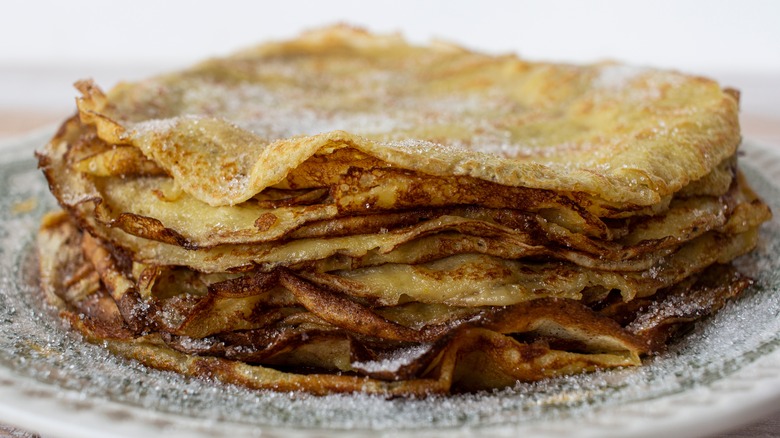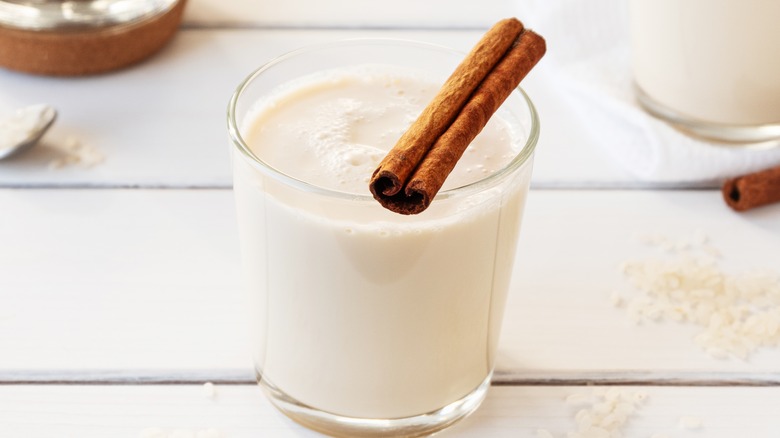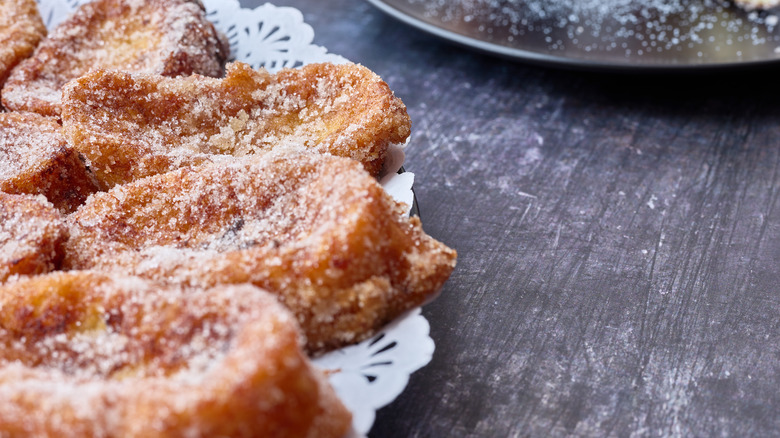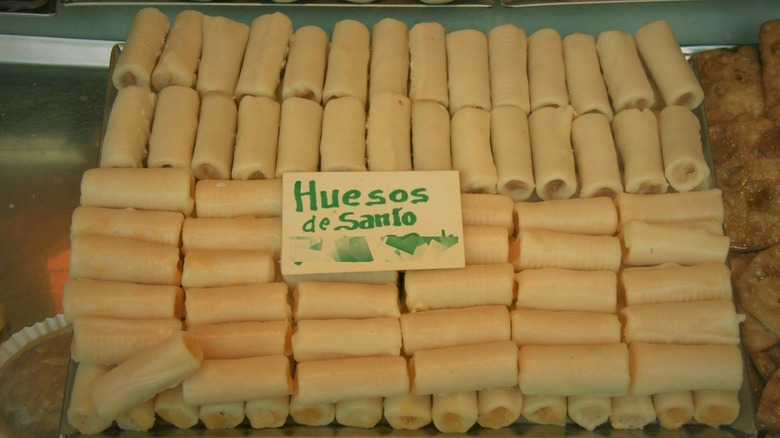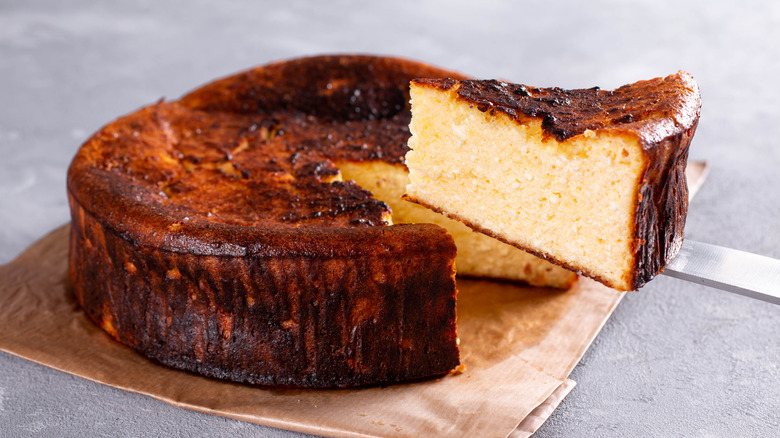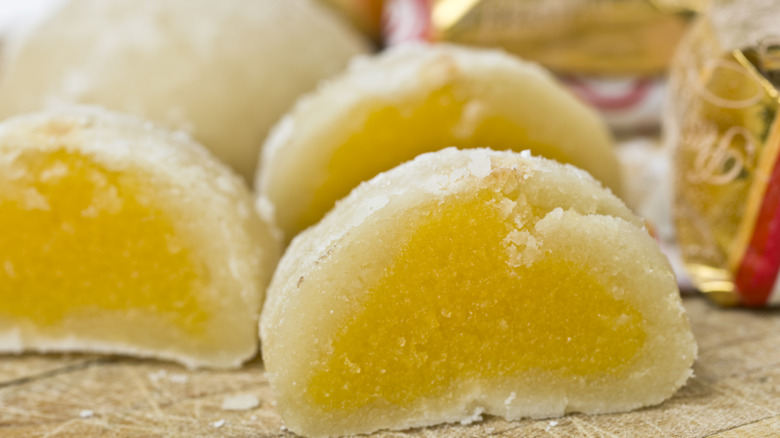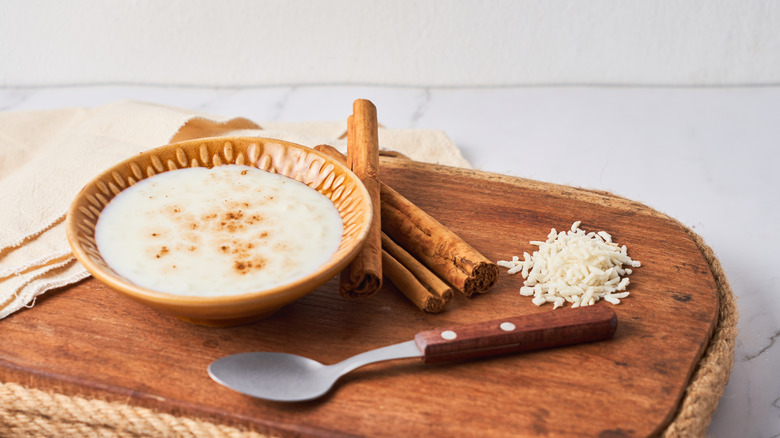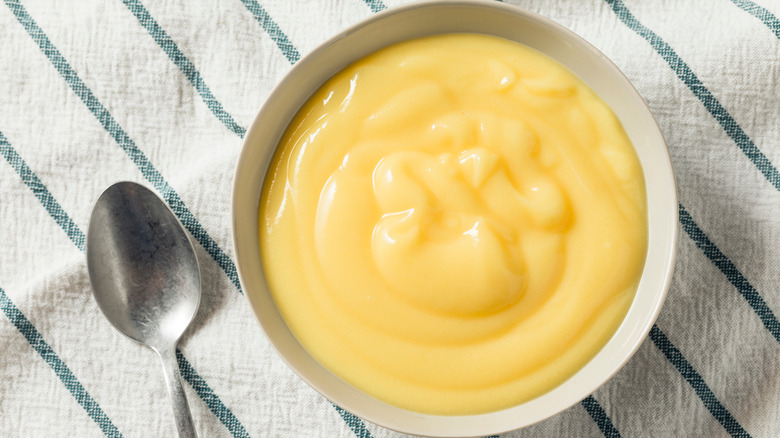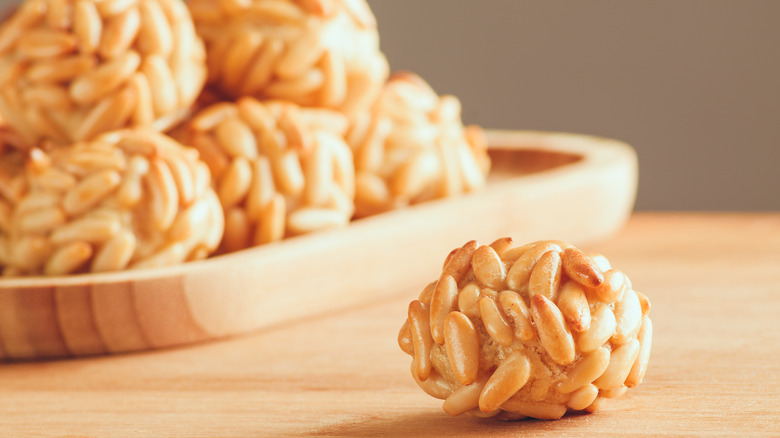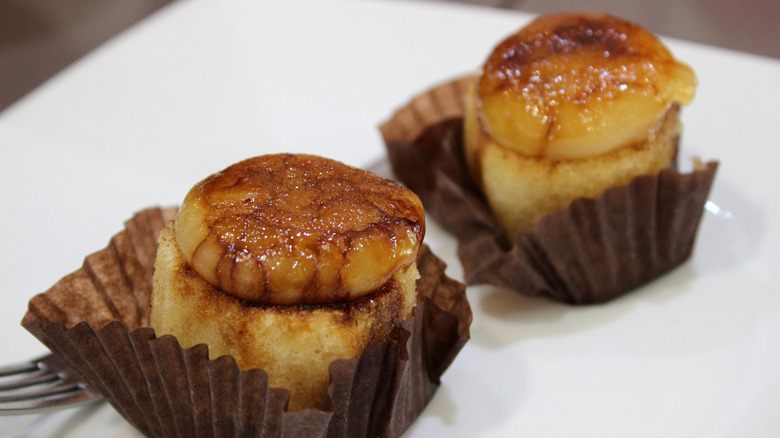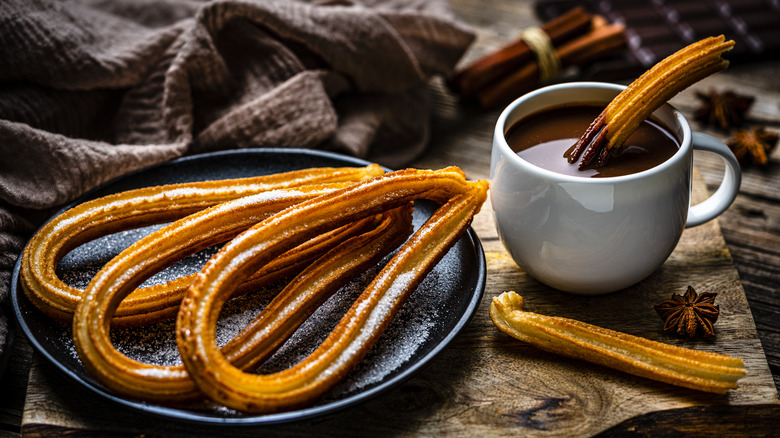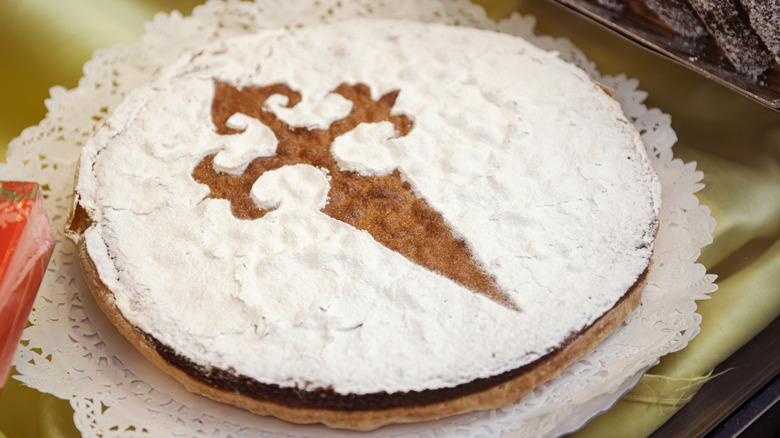17 Authentic Spanish Desserts You Need To Try At Least Once
Ginormous pans filled to the brim with seafood medley paella, crafty little tapas plates of pan con tomate and boquerones en vinagre, hearty helpings of patatas bravas and Spanish tortilla, and delicate slivers of the finest jamón ibérico with garlicky olives galore are just a few of the things that make Spain a glutton's delight. But did you know that Spain's dessert scene is just as mouthwatering? It's true; from silky custards and cinnamon milkshakes to crispy sugared fritters and dense shortbreads, Spain's sweets scene (say that five times fast) wins the hearts and palates of plenty.
Take crema Catalana, for example, a decadent predecessor to its cousin up north in France, creme brûlée. Or how about torrijas, a Lenten staple of moist, cinnamon-sugar toast thought up by nuns in the 15th century? Then there's the ever-ubiquitous churros, deep-fried and served with hot chocolate, and the delightfully scorched crust of Basque cheesecake. Much like the country's savory dishes, Spanish desserts are steeped in rich history and flavor and belong at the top of any foodie's bucket list.
Leche frita
Imagine crispy bitesize cubes of deep-fried custard dusted with a thick layer of cinnamon and sugar — that's precisely what Spanish leche frita is. Tracing its roots is difficult — some claim that leche frita was a means for Catholic nuns to support their convents; others say that the fried bites can be traced to Spain's Moorish era and were influenced by the conquering Arabs. Whatever their origin, leche frita is so beloved across Spain that various regions, from Valladolid to the Basque Country, claim it as their own.
While its origins are complicated, its ingredients are anything but. All you need to create this tasty treat at home is an egg, flour, cornstarch, milk, sugar, and a cinnamon stick. It comes together by allowing the milk, cornstarch, and sugar to thicken while additional milk and a cinnamon stick infuse on the stove before all of the ingredients are combined and chilled. Once the mixture has chilled, it's time for a quick toss in an egg wash and flour before frying to a crisp and coating with cinnamon and sugar. Leche frita is best enjoyed with a stout cup of black coffee, which brings out its creamy texture and sweet, milky flavors.
Turrón
Turrón is the ultimate Spanish Christmastime treat of nutty nougat goodness. This sweet delicacy hails from Jijona, a sleepy little village not far from the shimmering shores of Alicante, and can be traced back more than 500 years to the time of the Moors. While it's a staple over the holiday season, it can be enjoyed year-round.
Turrón is made with a delicate balance of honey, sugar, egg whites, and loads of toasted almonds that give it its signature crunchy, caramel flavor. Like many Spanish recipes, its preparation is pretty straightforward and can be made at home if you're not up for a trip across the Atlantic or to your nearest Spanish grocery. Simply create a candy slush by heating the honey and sugar on the stove before carefully stirring in the egg whites, followed by the almonds, and allowing the mixture to cool on a baking sheet before cutting.
Polvorones
These crumbly shortbread cookies known as polvorones take their name from polvo, or dust in Spanish, thanks to their thick blanket of powdered sugar. While today they're a quintessential holiday treat, their origins are a bit darker. Polvorones were used as a tool during the Spanish Inquisition to tell who was Jewish or Muslim, as the original recipe contains pork.
Traditionally, polvorones came together with a base of lard and just a handful of other ingredients, such as lightly toasted flour, ground almonds, and a whole bunch of powdered sugar. Lard may seem like an unusual ingredient for a sweet, but it adds a completely different layer of richness, and when you consider how central pork is to Spanish cuisine overall, it makes a great deal of sense. Polvorones can also be found across the Philippines where, in the centuries since their Spanish colonization, the country has made the dessert into something uniquely its own.
Crema Catalana
A close cousin to the ever ubiquitous creme brûlée just over the Pyrenees Mountains, crema Catalana is the ultimate creamy indulgence with its soft, velvety inside and crunchy, caramel crust on top. As the name suggests, crema Catalana comes from the gorgeous, coast-hugging Catalonia region of Spain, and what sets it apart from its French counterpart is the use of milk instead of cream and subtle hints of citrus and cinnamon.
The use of milk instead of cream makes for a lighter, but equally delicious, custard base, while the torched layer of caramelized sugar on top provides a satisfying crack. The exact origin of both crema Catalana and creme brûlée remains a mystery, but its worth noting that crema Catalana beat creme brûlée to the table by a few hundred years.
Pestiños
Originating from Andalusia, these crispy, twisted, deep-fried pastries are a must-try around Christmas and during Holy Week, Spain's (and most of the Catholic world) Easter season. Made from a simple dough of flour, finely ground spices such as anise, cinnamon, and nutmeg, along with white wine, and olive oil, pestiños are fried to a crisp and smothered in honey or coated with cinnamon and sugar.
The magic is in the use of Spanish olive oil, which is naturally nuttier and fruitier than its Italian counterpart, and takes on a golden hue. The soft, nutty notes of the olive oil infused with the sweetness of the dough and honey, resulting in an irresistible crunch. Pestiños are best enjoyed with a glass of sweet wine, such as the D.O. Malaga, which can be used in the dough as well, or a cup of hot chocolate.
Frixuelos de Asturias
From flapjacks to crepes, and blini to poffertjes, pancakes are loved around the world — and Spain is no exception. In Asturias, a stunning region tucked away in northwest Spain and home to Picos de Europa, frixuelos de Asturias reign supreme. More crepe than a pancake, frixuelos de Asturias are paper thin and made with the usual suspects — flour, eggs, milk, and sugar — but are also often enriched with a cheeky pour of anisette liquor or brandy for added flavor.
They are delicious as a breakfast or light lunch and are a favorite during Antroxu, Asturias' lively carnival season. Enjoy them with a dollop of cream and local Asturian apple jam, a drizzle of honey, or a light sprinkle of sugar. To really get the full experience, gulp them down with traditional Asturian sidra.
Leche merengada
You've heard of Spanish horchata, but have you heard of leche merengada? Slightly similar to horchata in terms of taste, leche merengada is a traditional Spanish dessert drink that is sweet, creamy, refreshing, and akin to light ice cream.
Leche merengada's base consists of whole milk and frothy egg whites that, once frozen, create Spain's version of something between a milkshake and a smoothie. It all starts once the milk has been heated on the stove and is slowly infused with cinnamon, lemon zest, and sugar. Once it's had time to cool, the beaten egg whites are mixed in before the leche merengada finishes off in the freezer for a few hours. It's the perfect refreshment on a hot summer day and can't be beaten when paired with a few leche fritas.
Torrijas
There's French toast, and then there's Spanish torrijas. Like many Spanish sweets, torrijas utilize citrus and cinnamon and can be traced back to one of Spain's largest cultural pillars — the Catholic church. Traditionally eaten around Lent, torrijas were prepared and popularized by Spanish nuns in the 15th century as a substitute dish while abstaining from meat. As the dish continued to evolve around the holiday, red wine was incorporated as part of a Lenten tradition to symbolize the blood of Christ.
While still consumed as a Lenten dish today, torrijas can also be enjoyed as a tasty dessert for Catholics and non-Catholics alike. This decadent dish comes together by drenching stale bread in milk that has been steeped with cinnamon and citrus zest, followed by an egg bath, a shallow pan fry in olive oil, and a quick toss in cinnamon-sugar.
Huesos de santo
From Equador's guaguas de pan (bread babies) and Italy's fave de morti (beans of the dead), the Catholic world contains all sorts of interesting recipes that honor the dead for All Saints Day. Some are directly inspired by the Catholic church, while others also draw on indigenous traditions of the region. In Spain, one such dish used to commemorate the special day is huesos de santo or, in English, saint's bones.
Delicate sheets of sweet, nutty marzipan are tightly rolled before their centers are hollowed out and stuffed with a sugary egg yolk paste that serves as the 'bone marrow' of the dish. The end result is bitesize 'bones' that commemorate the many sacred relics of saints found in Cathedrals across the world.
Basque cheesecake
Airy, creamy, and perfectly charred all at once, Basque cheesecake is in a league of its own. Hailing from the same region known for its plethora of local dishes like pintxos, coal-grilled cod, Idiazabal sheep's cheese, and txakoli sparkling white wine, Basque cheesecake keeps in line with other dishes of the region — it's both delicious and distinctly Basque.
What makes Basque cheesecake unique is that unlike other types of cheesecake, like New York style and Japan's soufflé style versions, is that it is baked at a high temperature to develop a burnt, slightly crispy, caramelized crust that leaves a subtle yet noticeable hint of vanilla throughout the rest of the cake. It's best devoured after it's had time to chill, allowing the crust to set and the caramelization to seep into the rest of the cake.
Yemas de San Leandro
A peek through the history of Catholic cuisine in Spain will reveal many delectable treats made by nuns, either to support their convents or their local communities. One shining example of such a treat is yemas de San Leandro. Made by the nuns of Convento San Leandro, a 13th-century convent in Sevilla, these tasty cookies offer the perfect dose of sweetness and culture.
Yemas de San Leandro is made with just three simple ingredients: egg yolks, lemon juice, and sugar. Not unlike the famous cloistered nun cookies of Madrid's Monasterio del Corpus Christi, yemas de San Leandro are acquired by placing money in a rotating tray that will then be replaced with the thoughtfully prepared cookies that have been wowing many folks with sweet tooth's for centuries.
Arroz con leche
It has long been known that rice goes way beyond the savory realm. In Turkey, firin sütlaç wows with its caramelized crust and gooey interior, while the Lunar New Year is often marked with eight treasure rice topped with candied lotus seeds, dried apricots, and other tasty delights. And in Spain, there is the iconic dessert of arroz con leche.
Very well known and much loved throughout Spain and much of Latin America, arroz con leche is a simple, satisfying dessert made of rice stewed with milk, sugar, cinnamon, and citrus peels such as lemon or orange. It's your typical ride pudding taken to the next level. To complement the creaminess and subtle hints of cinnamon in the dish, arroz con leche pairs great with Pedro Ximénez sherry.
Natillas de leche
Few things are as satisfying as Spain's rich vanilla custard dish, natillas de leche. With so many custard desserts around the world, natillas de leche is often overlooked, but its silky smooth texture and lavish trinity of vanilla, lemon, and cinnamon make it easy to see why it's one of Spain's best-kept secrets.
Not to be confused with flan, natillas de leche is much thicker and takes on less of a gelatinous texture. The custard forms by vigorously whisking hot milk that has been infused with cinnamon sticks, lemon zest, vanilla, and sugar, into an egg and cornstarch slurry until a thick consistency forms. The preparation takes great patience, though — you don't want scrambled eggs in your natillas de leche.
Panellets
Hailing from Spain's Catalonia region, panellets are another traditional sweet prepared around All Saints Day. These tiny balls of nutty goodness are typically served in sphere or rectangle shapes and come in a variety of flavors — coffee, cinnamon, chocolate, and beyond. However, no matter the shape and flavor, all panellets have the same delicious marzipan base.
Traditionally, panellets are made with almond meal and boiled potatoes that work as a base for the marzipan dough, are enriched with sugar and plenty of lemon zest, and are covered in pine nuts for a crunchy exterior. Known for their hefty price tag and difficult harvesting methods, the pine nuts are what really make panellets feel fit for royalty, or in this case, saints. Their exact origins are a bit murky, but they likely evolved from ancient funerary traditions that involved preparing small rolls of bread to bring to the church or leave at the graves of loved ones during the season.
Pionono
Pioanono are tiny, chunky, irresistible pastries that come from the little town of Santa Fe, not far from Granada, where pionono is essentially the unofficial dessert of the city, and we're here for it. The heart of pionono is a chubby little sponge cake stuffed with cinnamon-spiked cream and custard; a torched, caramelized cap is on top.
This cute little dessert was created in the 19th century when Pope Pius IX was honored by local confectioner, Ceferino Isla Gonzales, on the 50th anniversary of his passing. Thus, the pionono was born, its stout shape resembling the beloved pope's. Due to its rich, almost rum-like flavor, pionono is another Spanish sweet treat best enjoyed with a few sips of PX sherry or stout black coffee.
Churros
Crispy on the outside and soft on the inside, these delectable sticks of fried dough are an iconic Spanish dessert and a must-try for anyone with a serious sweet tooth. Traditionally served with a rich, velvety cup of hot chocolate for dipping, churros can be enjoyed plain or with a generous dusting of sugar and cinnamon. It may seem like a sweetness overload, but trust us, the cinnamon and sugar option is the way to go.
For an authentic experience, there's no better place to try them than Chocolatería San Ginés, a bustling coffee and churros spot in Madrid with a history dating back to 1894. But if you can't make it to the Spanish capital just yet, get crafty in the kitchen and try making some churros at home.
Tarta de Santiago
Any visit to Spain, or a Spanish restaurant for that matter, includes a long list of authentic foods to try — and among them is the tarta de Santiago, a traditional sweet hailing from the country's Galicia region. A centerpiece in any Spanish celebration of the Feast of Saint James, this dense citrus and almond cake is always clad with the cross of the late saint who is closely associated with Santiago de Compostela, a famous Christian pilgrimage site in Santiago where Saint James' tomb is also located. Due to its popularity and preservation through the centuries, this traditional Galician cake also holds its own Protected Geographical Indication, putting it in the same ranks as German bratwurst, Cyprian halloumi, and Turkish baklava.
Not only is this beloved Spanish dessert a symbol of culture and tradition, but it's also naturally gluten-free. Its star ingredient is ground almonds that give the cake a nutty flavor perfectly complimented by cinnamon, lemon, and a thick blanket of powdered sugar on top that make for a perfect aromatic indulgence. Because of the scarcity of almonds in Galicia in the 16th century, tarta de Santiago also worked as a sort of status symbol for the Galician elite, as only the region's wealthiest would have been able to afford such a large amount of almonds for a cake.
